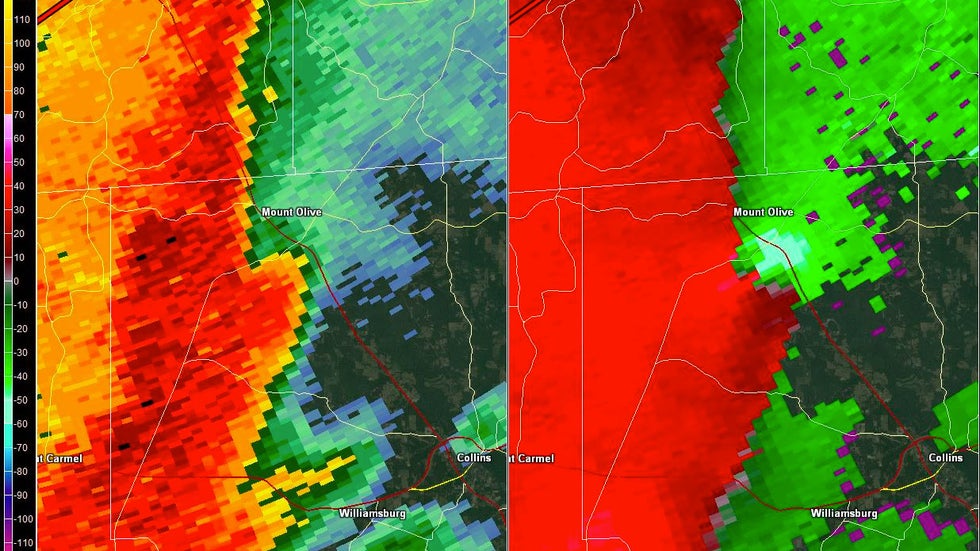Chris Dolce
Published: April 9, 2020
Squall line is a common term you might hear meteorologists say when there is a threat of severe thunderstorms in your area.
Here's what to know about this dangerous phenomenon and why you should take it seriously.
What Is a Squall Line?
Squall lines are thunderstorms arranged in a line, often from north to south. They can be hundreds of miles long, but are usually only about 10 to 20 miles wide.
Here's a forecast model depiction showing what a squall line typically looks like on radar. Keep in mind, the squall line can be broken into two or more parts, and sometimes severe thunderstorms called supercells can form ahead of it.

Why Are They Dangerous?
1. Destructive Straight-Line Winds
Nearly all squall lines have strong winds in them, but some are more intense than others. The strength of the winds depends on variables like how unstable the atmosphere is, and the strength of winds above ground level.
From 2013-17, an average of more than 14,000 reports of winds of at least 58 mph or wind damage were logged annually in the U.S., according to data from NOAA's Storm Prediction Center.
Winds this strong are capable of downing tree limbs and knocking out power at the very least, but they may also be strong enough to down trees onto homes, vehicles or anything else in their way. Those winds are also strong enough to produce damage to homes and other buildings. The wind can also worsen the damage from large hail since it accelerates the hailstones into vehicles and the siding of homes.
Stronger squall lines commonly produce wind gusts from 60 to 80 mph. A derecho is a type of squall line that meets certain criteria and can spawn gusts over 100 mph, the equivalent of an EF1 tornado, in extreme cases.
An extreme example of the damage straight-line winds in a squall line can cause happened in the Dallas-Fort Worth metro area on March 28, 2017.
Power poles were snapped in Fort Worth and several homes were damaged in Rockwall County, Texas, where the NWS estimated 90- to 95-mph winds caused substantial structural damage, including to the house pictured below.
When the NWS issues a severe thunderstorm warning for dangerous winds in a squall line, you should seek shelter as you would when a tornado warning is issued.
2. Tornado Threat
Tornadoes are also a common threat found in squall lines.
Sometimes brief tornadoes develop quickly along the leading edge of a squall line of severe thunderstorms with otherwise damaging straight-line winds.
These typically brief tornadoes may occur overnight or be rain-wrapped and difficult to see.
Many of the tornadoes in a squall line are rated EF0 or EF1. But occasionally they can be strong and produce EF2 or worse damage.
Below is a Doppler radar image showing an EF2 tornado that developed in a squall line and struck Mount Olive, Mississippi, on Jan. 2, 2017. The small notch just below the Mount Olive label depicts the rotation in the squall line indicating where the tornado was on the ground for just over 4 miles.

3. Blinding Rain and Dangerous Lightning
Extreme rainfall rates of an inch or more per hour can occur in a squall lines.
If you are driving when the heavy rain hits, visibility can drop to just a few feet in front of your car in a matter of seconds. Travel should be avoided when a squall line hits, but never use a highway underpass as shelter.
Thousands of cloud-to-ground lightning strikes per hour can also occur in a squall line. Lightning can persist for a half-hour or longer after the squall line and the highest winds have already passed.
With lightning nearby, avoid contact with electrical devices, corded phones and metal pipes while indoors. It is safe to go outdoors 30 minutes after hearing the last clap of thunder.
The Weather Company’s primary journalistic mission is to report on breaking weather news, the environment and the importance of science to our lives. This story does not necessarily represent the position of our parent company, IBM.
The Weather Company’s primary journalistic mission is to report on breaking weather news, the environment and the importance of science to our lives. This story does not necessarily represent the position of our parent company, IBM.



No comments:
Post a Comment